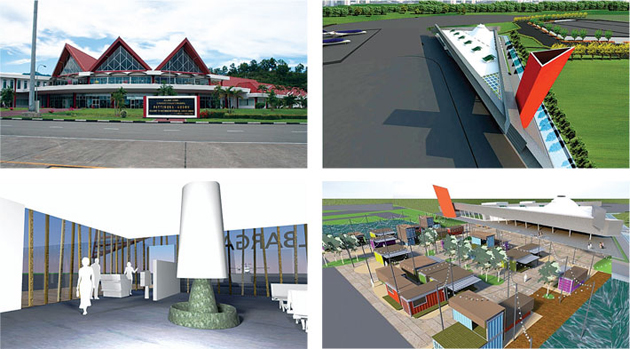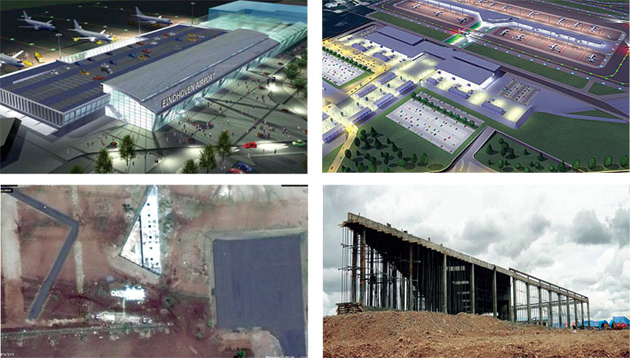Lean Airports for Remote & Regional Aviation
An integrated solution is achieved that both cuts down the terminal area space requirements (no check-in hall) which reduces the running costs of services and maintenance and lowers manpower costs at the same time
In the remote Indian region of Gulbarga a case study of lean airport infrastructure development is getting ‘cast in stone’. In the near future, the first turboprops will land and the optimised terminal building will process its first passengers, using minimal square metres in a facility that is based on a complete dress-down of the core operational processes. Yet the solution that resulted from this case study has such elegance in its simplicity that it has emboldened the local administration to invest in its construction and thus secure this remote region’s connectivity to India’s growth story.
This article aims to provide further background to the Gulbarga case study and its relevance to remote region connectivity, covering the demand that was identified, its practical application and its regulatory context and relevance for today’s airport manager and local administrators. It will give airport managers and regional authorities an overview and background to innovative case studies of lean airport infrastructure developments which combine both optimised CAPEX and running costs/OPEX without losing sight of the aspirational nature of up and coming remote regions; a truly sustainable model.

Introduction
The vast hinterland of countries such as Russia, China, Brazil and India, or the remote islands of Indonesia and the Pacific archipels, all look to air transportation to find connectivity with their countries’ key growth centres and the wider world economy.
How can local administrators or regional airport developers cover the expense of developing essential airport infrastructure to safely facilitate this remote air connectivity? The case study discussed here provides possible answers.
Case Study — Gulbarga
Gulbarga, a remote region in Karnataka, is finding it challenging to keep pace with the country’s premier economic growth centres. One of the key missing factors is connectivity; India has a vast internal market, but limited transportation infrastructure and a challenging supply chain. This means that businesses can only prosper if they are in close proximity or have seamless connectivity to their main markets; the large metropolitan areas. This is something Gulbarga was lacking.
Emboldened by the rise of affordable air travel, local and state administration agreed that Gulbarga should tap into this potential of fast connectivity and launched an initiative for the establishment of an airport at the heart of the district.
The Requirement
Due to the modest revenues expected from the two or three flights a day, a key requirement for the proposed Gulbarga airport was to keep both the CAPEX and OPEX as lean as possible, without compromising on safe and secure operations.
Capital Projects consisted of the runway, aircraft parking apron, a connecting taxiway between the two, an isolation pad, a rescue & firefighting facility, air traffic control facility, a boundary wall and a passenger terminal with vehicle surface parking (passengers/well-wishers and staff).
Operations consists of airline staff functions (check in, pre-boarding check, etc.), aviation security (passenger & baggage check), ground handling (baggage), air traffic control, rescue and firefighting, airport maintenance & landsideairside boundary security.
A step-by-step account is given of how the requirement identified for this case study will be met, namely to cater to the demand of safe air connectivity with facilities that are lean and allow for optimised running costs/OPEX.

The Study
Although limiting the CAPEX was important for the case, the focus of the study was predominantly on reduction of OPEX, since running costs of a project over time constitute a larger financial burden than its one-time capital costs. The running costs could be broken down into two main drivers, namely facility/utility services & maintenance and manpower costs.
Facility/utility services & maintenance costs were analysed to determine how they could be reduced to a minimum. It was concluded that the most effective and practical way to achieve this was to reduce the total square metre area required for safe operations down to the bare essentials; firstly, the runway was planned based on the minimum requirements for aircraft with lesser loads and shorter take-off distance, since this sufficiently met the limited forecasted demand for the first five years of operation (max 70 passenger aircraft). This meant a considerably shorter runway than required at airports with more mature traffic.
Next, the terminal space requirements were analysed, looking at the minimal area required for efficient execution of its core functions. In this, sufficient space for queueing was taken into account.
Manpower costs, on the other hand, were reduced by exploring ways in which non-essential functions could be avoided and overlapping functions could be integrated into a single function. For example, designing the aircraft apron in such a way that it would allow aircraft to park on the apron in a ‘power-in/powerout’ fashion, makes the operation of aircraft-tugs redundant. This also means a reduction in airside staff.
WHEREAS ‘LOW-COST’ TERMINALS HAVE BEEN CONCEPTUALISED IN THE PAST, THEY HAVE FALLEN SHORT OF BEING AS LEAN IN TERMS OF CAPEX AND OPEX AS THE GULBARGA TERMINAL
For the terminal design, the security functions of entrysecurity and the passenger (and hand baggage) security check were combined by bringing the passenger check-in process to the façade of the terminal building. Passengers can check in their bags and wait at the plaza in front of the terminal with their well-wishers and make use of the food and beverage options there.
This terminal configuration results in a single security check at the time the flight’s pre-boarding announcement is made and passengers move into the transient pre-boarding lounge, reducing the manpower requirements of the security agency (in India the Central Industrial Security Force).
In this manner an integrated solution is achieved that both reduces the terminal area space requirements (no check-in hall) which reduces the running costs of services and maintenance and reduces manpower costs at the same time.
Not only does the solution reduce the terminal by a large square metre area (the check-in hall), it also lowers the services requirement for another area in the terminal; the preboarding lounge. Since the dwell time in this space has been reduced to a minimum (from pre-boarding announcement to actual boarding of the aircraft), it has truly become a ‘transient’ space which can be serviced with reduced intensity. In the climatic conditions of Gulbarga, this meant it was feasible to suggest a passive cooling system that had successfully be implemented in the district’s police headquarters a few years prior. This further reduces the running costs of the facility and reduces the dependency on high-cost maintenance and replacement for building services.
Bringing the passenger check-in process to the façade of the terminal building has another added advantage; it allows passengers to wait for their flight together with their accompanying well-wishers at the plaza in front of the terminal, instead of being confined to the terminal. Together with arriving passengers and welcomers, sufficient footfalls are created at the plaza for shops & cafes for comfort and conveniences. With the right kind of lease-agreement, the revenue-share of these establishments will contribute to the airport’s business case.
The solid foundations of the business case; the reduced building volume, lean CAPEX, OPEX, and assured footfalls and revenues from food and beverage sales, in addition to the standard aeronautical revenues, allow for a small investment in the terminal’s appearance; a unique roof that gives identity to the airport and is visible from afar. This is not only important for passengers identifying the terminal, but also for the people of the district to identify with the project.
Setting the Benchmark
Whereas ‘low-cost’ terminals have been conceptualised in the past, they have fallen short of being as lean in terms of CAPEX and OPEX as the Gulbarga terminal. This can best be illustrated by the following examples that NACO (Netherlands Airport Consultants) was involved in:
Kuala Lumpur International Airport Terminal 2 was initiated as a ‘low-cost’ terminal design project to cater to the growth of the low-cost carrier (LCC) AirAsia. However, the pressure to make the terminal another icon of Malaysia’s premier gateway airport, resulted in an increased CAPEX (large terminal area and iconic architecture) and OPEX (aerobridge operations & challenging cleaning/maintenance).
The Eindhoven Airport Terminal in the city of the electronics & lighting conglomerate Philips in the south of the Netherlands, on the other hand, achieved many of the ‘low-cost’ targets, driven by the demands of its principal airline customer, low cost carrier Ryan Air; an efficient terminal layout and a large part of the pre-boarding process organised outside the façade of the terminal (distribution of passengers on the apron, using flexible fencing system).
All the features were integrated in the design to guarantee the quick turnaround time and low airport charges demanded by Ryan Air. The optimised CAPEX was later somewhat skewed by the airport expansion which resulted in an unnecessarily deep check-in hall and an iconic multi-story hotel on top of it (NACO was not involved at that stage).
The terminal concept for Frankfurt Hahn Airport Terminal, developed by NACO, was heralded by the promoter of the world’s most successful low-cost carrier (Ryan Air) Micheal O’Leary: “I wanted to say how pleased and impressed we are at the simplicity, efficiency and effective use of space design. I have no doubt that this new terminal will set a new benchmark for terminal facilities not just across Europe but indeed worldwide.” Despite the praise, unfortunately this terminal was never built.
These examples have made it evident that the focus on lean CAPEX and OPEX through full optimisation of operations and functional planning can only be fully successfully retained if there is a real necessity.
The Gulbarga case study once more clearly shows that ‘necessity is the mother of invention’. It can serve as a benchmark for future airport developments in remote regions.
— The writer is Region Manager, Netherlands Airport Consultants (NACO)





